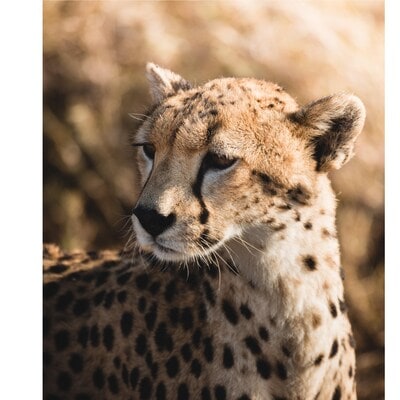India considered sourcing new cheetahs from Somalia, Tanzania, Sudan and other range countries closer to the equator or in the Northern Hemisphere to avoid biorhythm complications seen in big cats brought in from Southern Hemisphere countries such as South Africa and Namibia, according to official records.
Due to differences in circadian rhythms between the Northern and Southern Hemispheres, some cheetahs developed thick winter coats during the Indian summer and monsoon last year, in anticipation of the African winter (June to September).
Three of these cheetahs (a female from Namibia and two males from South Africa) died after wounds under their winter coats on their backs and necks became infested with maggots and caused blood infections.
PTI has learnt from sources that cheetahs in Namibia and South Africa have again grown thick winter coats. Despite these concerns, talks are underway with countries in the southern hemisphere to bring in new cheetahs.
“Talks are underway with all countries, including South Africa and Namibia, but we have not formally approached any of them. Currently, our focus is on addressing immediate issues like increasing the prey base, managing the leopard population and preparing the Gandhi Sagar Wildlife Sanctuary,” a source told PTI.
Documents obtained by PTI through an RTI application revealed that during a steering committee meeting on August 10 last year, chairman Rajesh Gopal said the time taken by cheetahs from southern hemisphere countries to adapt their biorhythms to the local environment, climate and conditions at Madhya Pradesh’s Kuno National Park could be a major factor in their deaths.
“Due to lack of biorhythmic adaptation, some cheetahs have succumbed to ectoparasitic infections during their moulting period, which was synchronized with the climatic conditions of their previous habitat. The third filial generation of surviving cheetahs would be more resilient and better adapted to the conditions at Kuno,” Gopal said at the meeting.
She acknowledged the potential for increased mortality due to this problem and recommended that “future cheetahs for reintroduction should come from northern hemisphere countries such as Kenya or Somalia to avoid biorhythmic complications.”
According to the African Range-Wide Cheetah Conservation Initiative, southern and eastern Africa are strongholds for the species, although there has been significant range loss in parts of these regions.
The current distribution in several countries, such as Sudan, Somalia, Eritrea, Angola, Mozambique and Zambia, remains largely unknown.
At a steering committee meeting on September 4, Gopal reiterated the importance of synchronizing biorhythms, particularly circadian rhythms, with local weather conditions.
He stressed that South African cheetahs are adapted to the climatic conditions of the southern hemisphere, which has a different climate regime. It is therefore essential that the National Tiger Conservation Authority prioritises obtaining new cheetahs from northern hemisphere countries such as Kenya and Somalia.
Taxonomic variation between subspecies is not particularly significant, “as South African cheetahs also belong to a different subspecies,” he explained.
At another meeting on 27 October, the committee stressed that cheetahs should not be sourced from southern African countries, based on experiences with circadian rhythm disruptions and skin infestations.
At the next meeting on 13 December, Amit Mallick, then Inspector General of Forests at the NTCA, said steps had been taken to “bring in more cheetahs from other range countries, including Kenya, Tanzania and Sudan”.
However, this issue was not taken up in the subsequent meetings on 12 March, 18 June and 23 August, which focused on prey enhancement, leopard population management in Kuno and Gandhi Sagar Wildlife Sanctuary, pasture restoration, capacity building, strengthening of standard operating procedures and finalising the cheetah release schedule in Kuno.
Some of the 20 cheetahs brought to India so far (eight from Namibia in September 2022 and 12 from South Africa last February) were initially released into the wild but were returned to their enclosures on August 13 last year after three cheetahs died due to septicaemia.
At a meeting on Friday, the steering committee decided to release the African cheetahs and their cubs, born in India, into the wild in a phased manner after the monsoon withdraws from central parts of the country, which usually happens in the first week of October.
“While adult cheetahs will be released into the wild in phases once the rains are over, cubs and their mothers will be released after December,” an official told PTI.
The 25 cheetahs (13 adults and 12 cubs) are doing well. The animals have been vaccinated to protect them from diseases and have been given a prophylactic drug to prevent infections, according to the official.
(Only the headline and image of this report may have been reworked by Business Standard staff; the rest of the content is auto-generated from a syndicated feed.)
First published: August 26, 2024 | 00:39 IS
Disclaimer:
The information contained in this post is for general information purposes only. We make no representations or warranties of any kind, express or implied, about the completeness, accuracy, reliability, suitability or availability with respect to the website or the information, products, services, or related graphics contained on the post for any purpose.
We respect the intellectual property rights of content creators. If you are the owner of any material featured on our website and have concerns about its use, please contact us. We are committed to addressing any copyright issues promptly and will remove any material within 2 days of receiving a request from the rightful owner.

